S.C. Skillman's Blog, page 63
November 11, 2013
A Review of JK Rowling’s The Casual Vacancy
I’m a great admirer of JK Rowling both as an author, and on a personal level. So when I knew she’d published her first adult novel, I was keen to read it.
When I began to read The Casual Vacancy several months ago, I found it a struggle to get through the unrelenting nastiness of the characters, without finding any one individual I could identify or empathize with. And at that time I chose to put it down.

The Casual Vacancy/JK Rowling
Nevertheless, I was determined to come back to the novel later when I felt ready to tackle it. And I’m glad I did. I very quickly began to recognize elements from the hometown of my childhood – local characters & social/political/economic issues.
When the author begins to fill in the backgrounds of the characters, giving them greater depth, I started to feel, at some level, empathy for Terri, and for Krystal, and for their terrible plight – and glimmers of humour also relieved the grimness of the characters’ behaviour.
JKR inspires both pity & anger with her waspish vignettes of mothers who betray their children with submissiveness, moral weakness & cowardice, & fathers/husbands who trample close relationships with arrogance, intolerance & cruelty, & teenagers full of hatred & resentment. She also penetrates right to the heart of class consciousness & snobbery, & those who live with an innate sense of ‘superiority’. These attitudes riddle our society, & our hearts & souls; they blight lives, destroy hope, & ensure injustice and inequality prevails. They lower people’s self-esteem and propagate lies that last a lifetime. All this JKR skilfully conveys in The Casual Vacancy.
I found many sharp portrayals: the conversation as a social worker visits a drug addict; the inner life of a bullied teenager as she self harms, her situation made worse by a harsh, unsympathetic mother; the fragile threads upon which a drug addict’s rehabilitation depends; the pressures at home which force teenagers into depraved company and behaviour. JKR accurately conveys the effect that going to a certain sort of school has on one’s sense of self-worth, and upon the choices one makes in one’s friendships and future life.
It’s clear to me that the characters in this novel are behaving ‘their’ way – in other words, the default setting of human nature. It would be pointless and disingenuous for any of us who live in contemporary English society to pretend that we cannot recognize something murky of ourselves somewhere in this novel: something that points up the ‘devices and desires’ of our own hearts.
However, although I enormously admire what JKR has done in this story, I still feel it lacks a strong enough spiritual message or act of redemption at the end; and the potential for that is very strongly present as the narrative progresses.
JKR may not have wished to commit herself to an explicit spiritual message in the novel. But I cannot help feeling there is clear potential for an authentic Christian witness in this story, pointing to a different attitude, a different way of life.
Jesus knew all about the default setting of human nature, and the untrustworthiness of the human heart.
In John’s Gospel we read these words : But Jesus didn’t entrust his life to them. He knew them inside & out, knew how untrustworthy they were. He didn’t need any help in seeing right through them.
For The Casual Vacancy is, to me, essentially a story of ourselves as we are, now, in our communities, in our society today, just as we always have been; unredeemed, doing things ‘our way’ and not God’s way, and reaping the consequences. It’s only JK Rowling’s decision not to take the opportunity for a stronger redemptive message which prevents me from giving her book the highest possible rating.
Filed under: Authors I love, book reviews, Books, British, creative writing, life, literature, musings, SC Skillman, thoughts, UK, Writing Tagged: author, devices and desires, friendships, future life, God, hearts & souls, hope, human heart, human nature, Jesus, JK Rowling, lives, novel, our own hearts, published, redemption, spiritual, The Casual Vacancy


November 4, 2013
200 Years of Australian Art at the Royal Academy: Connections Between Painting and the Spiritual Realm
From indigenous art through to ‘discovery’ by European explorers, the arrival of the first British settlers, dismay, denial and idealization, to acceptance, new understanding and redemption, this exhibition of Australian paintings at the Royal Academy in London took me on a journey through the spiritual heart of my own experience of this great continent.

AUSTRALIA EXHIBITION, Royal Academy of Arts
As Russell Drysdale said, “In Australia there is a quality of strangeness that you do not find … anywhere else.”
Reviews of this exhibition have been mixed, with a lot of criticism levelled at it in the UK. But from the first painting of a convict settlement, neat, peaceful, well spaced out and idealized, through to the contemporary paintings struggling to reconcile the wounded history of cruelty, misunderstanding and conflict between aboriginal people and European colonial settlers, this exhibition was for me an opportunity to revisit and relive my own experience of four and a half years living in this great continent.
In particular a swirling picture by a Queensland artist of the rainforest-clad mountains near Brisbane seemed to reflect exactly my own experience of this beautiful landscape.
The indigenous artworks were particularly moving, with their distinctive use of rarrk – the cross hatched patterns characteristic of aboriginal artists, as they depict rain running down dunes, undulating landscapes, waterholes and trees and spirit ancestors, believing that we tread the earth for a while then come out of it and become part of the ancestral realm again.
Two phrases seemed to touch the heart of this exhibition : “access to” and “isolation from”. Both of these were exemplified in a painting by John Brack, The Car (1955) which I couldn’t help responding to with amusement and yet behind it lay a profound resonance: a family in an ugly cheap car, out for a day trip, the father at the wheel, the mother smiling, the two children in the back staring straight at you, the viewer… and behind them the vastness of the Australian landscape.
And the picture “Australian Beach Pattern” by Charles Meere (1940) of the bronzed perfect bodies on the beach, men, women, children and babies, all strong, confident, was for me worryingly reminiscent of the kind of the pictures produced by artists in the Soviet Union as part of a propaganda campaign for the Soviet communist party. Yet later, the trauma of the Second World War affected the mood of optimism and this image was superseded by Albert Tucker with a painting of red,scorched hunks of flesh on another beach.
There was no painting of Sydney Opera House, my favourite of all buildings; but there was one by Grace Cossington Smith of Sydney Harbour Bridge being built, (“The Bridge in Building”, 1929) viewed from below, demonstrating pride, hope, creative enterprise, ingenuity, and above, beyond and around it a distinctly spiritual resonance.
The indigenous people of Australia were the ones who fully understand and imbued the earth with sacred forces. They were the ones who gave this continent its air of mystery and spiritual power. And yet I can,too, be thankful to those eighteenth century settlers, because they prepared the way so that I,and many others, might have access to the most sublime of scenery. Even now when I drive up a steep winding road I think “Mount Glorious” . And when I saw Kenneth McQueen’s picture I thought “Yes!” And my heart lifted. “Maiala Rainforest” – conveyed just as I experienced it and remember it now, in swirling patterns of movement.
Filed under: Art, art exhibitions, Australia, buildings, history, inspiration, life, London, musings, places I love, SC Skillman, spirituality, thoughts, travel Tagged: aboriginal art, aboriginal paintings, ancestral realm, Australia, Australian art, Australian paintings, connections, London, mystery, Royal Academy, sacred forces, SC Skillman author, Spirit Ancestors, spiritual heart, spiritual power, spiritual realm, sublime landscape, touch the heart


October 28, 2013
Friends At Last: Building Trust in the Animal World
Molly has now overcome her resistance to the idea of an alien cat in the house with her (albeit her mother)
But it took Willow a little while to overcome her annoyance at her daughter Molly’s initial rejection of her.
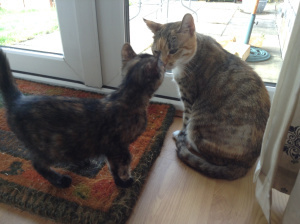
Willow and Molly 27 Oct 2013 (photo credit Abigail Robinson)
She spent a few days expressing her annoyance, and trying to exert some discipline.
She was a strict mother,and we watched her setting the boundaries.
“Behave!” she would say to Molly.
And then she discovered what it’s like to have your young one defying orders.
And later I was reminded of one of those classic situations which many young mothers bemoan; the toddler who won’t even let her mother go to the toilet alone.
Molly has been pushing at the door of the litter tray while Willow is in it, trying to jump in with her.
“Can’t I even go to the toilet in peace?” cries Willow.
Now we hear the scampering of feet across the floor as the two play-fight with each other and chase each other from room to room.
Relaxing? No. And sometimes those play-fights look horribly real.
But I reassure myself that the claws are retracted.
Otherwise the squeals and squeaks and cries that come from 8 week old Molly would be screams of pain.
Watching a relationship of mutual trust being built in the animal world has made me reflect on how this may apply to us humans too. Suspicion breaks down, the first tentative steps are taken; building trust is a process of experimentation and small moves forward. So we see ourselves and our own characters partially reflected in animal behaviour.
Filed under: animals, interpersonal relationships, life, musings, nature, SC Skillman, SC Skillman Author, thoughts, wildlife Tagged: animal behaviour, animal world, building trust, cats, characters, daughter, family relationships, felines, interpersonal relationships, mother, rejection, relationships, SC Skillman author


October 21, 2013
Mother and Daughter Relationships – Poignant Family Drama in the Animal World
Mother and daughter relationships – a popular trope in TV sitcoms/family sagas/romantic fiction/women in jeopardy/social and romantic comedies and many other stories.
And in the last few days my family have been immersed in a poignant drama in our home between a mother and a daughter.
A mother who was separated from her little girl three weeks ago, and is excited to be together with her, and who longs to come close and look after her again.
And a baby who was separated from her mother, but now they’re reunited, she’s suspicious and hostile.
She spits, hisses and growls at her mother. And the hurt mother, cross and rejected, growls back – through the glass door that separates them.
The name of the mother: Willow, age 18 months.

Willow investigating the scratching post (photo credit Abigail Robinson)
And the name of her little daughter: Molly, age 8 weeks.

Molly age 8 weeks (photo credit Abigail Robinson)
Willow is a tortoiseshell/tabby cat and Molly a sparky little dark tortoiseshell.
Ever since Willow and Molly arrived in our home, side by side in their cat-carrier, courtesy of the Cats Protection League two days ago, I’ve watched this little family drama in the world of felines with a mixture of emotions.
And so has my own teenage daughter.
“It’s your mum! She just wants to be nice to you!”
No, she’s hiding in a hammock of her own creation at the back of the sofa; a hammock we’d never known was there.
Perhaps next week when I blog again, mother and daughter will be reconciled and happily curled up together again.
Filed under: animals, interpersonal relationships, life, love, musings, SC Skillman, SC Skillman Author, thoughts Tagged: animal world, cats, emotions, family drama, family relationships, felines, happily, hurt, in the world of, mother and daughter, poignant, reconciled, rejected, relationships, reunited, tortoiseshell tabby


October 14, 2013
Challenging False Ideas of God: The Judge-Who-Could-Never-Be-Pleased, or Perfect Love and Limitless Goodness?
‘”These things are sent to try us.”

Rev Kenny Borthwick, Church of Scotland minister (photo credit holytrinity-westerhailes.org.uk)
This is just one among many cliches in the English language that we use without thinking.
Yet how often do we stop to realise they are meaningless?
Who sends these hard things to ‘try’ us? An almighty sadist in the sky?
This stands as one of the most popular arguments against Christianity. How can a supposedly all-loving sovereign God allow terrible things to happen to innocent people?
When I was in the sixth form at school we had an atheist English teacher who enjoyed challenging us on a personal level, arising from discussions about Thomas Hardy’s Tess of the d’Urbervilles.
Thomas Hardy was “a philosophic pessimist” and in Tess’s tragedy he suggests there is no purpose or meaning to her suffering, other than that “we live on a blighted star.”
Our teacher said, “All the evidence suggests that there is a random pain-inflictor, scanning round over human affairs, occasionally dropping a huge lump of tragedy onto someone.”
Discuss.
This would indeed be a good exam question in Religious Studies.
Two days ago I listened to a Church of Scotland minister, Kenny Borthwick, talk about why God does not send things to try us, and why the real battle when we suffer is to hold onto the goodness of God.
Kenny spoke to a large audience as part of a day organised by The Well Christian Healing Centre in Leamington Spa.
God, he said, is not a harsh God whose main aim is to teach us hard lessons through hard things.
Although it is true we can sometimes learn valuable things through suffering, we must be aware of this danger: if you over-stress a truth it can become a lie.
God does not send cancer to teach us a lesson.
God sent Jesus to teach cancer a lesson.
Kenny Borthwick is exactly the opposite of a traditional fire-and-brimstone preacher so beloved of numerous novels written by Catholic authors about their upbringing among religious authorities with a harsh view of God (how can I ever forget the sadistic priest in James Joyce’s Portrait of the Artist as a Young Man?) No religious authority figure has ever spoken to me like that; and yet we somehow recognise the cruelty and the fanaticism in this character.
Benny Borthwick spoke of Christians who magnify badness and repentance and magnify the strictness of God with a zeal He would not own.
Kenny’s message to Christians was this:
“You have been saved into the love of God, the goodness of God that He wants to pour into your life day by day.”
The face of God-the-Judge-Who-could-never-be-pleased disappears for ever.
BUT once we accept this, there is still a process.
When we live from the goodness of God which is limitless, we realise that today and every day we always have something to offer, whoever we are, even if we believe we have nothing – we always have something to give.
We need to reject a false spirituality which is frightened to use words like illness or depression, and frightened to cry and be distressed.
We can live each passing moment as a gift from God.
Jesus gave the water a new history when he turned it into wine.
He can give us a new history, with a sense of our new identity. When we are able to accept this, we can realise that our present doesn’t need to be controlled by our past.
Then we are able to make new choices – hope and trust rather than fear.
Then we can replace the old false spirituality and lies with a great truth:
“God can give me a new destiny”.
Filed under: Books, faith, inspiration, interpersonal relationships, life, literature, love, musings, people of inspiration, psychology, religion, SC Skillman, SC Skillman Author, spirituality, thoughts Tagged: cancer, Christians, depression, destiny, false spirituality, gift from God, God, goodness, harsh God, hope, innocent people, Jesus, love, loving God, past and present, spirituality, suffer, terrible things to happen, trust, truth, water into wine


October 9, 2013
What Do We Do About Art? There’s Always a Little Shop At The End
What do we do about art when we wander around great art galleries and musums?

How I integrate art into my own life, on the wall of my writing space (photo credit Jamie Robinson)
We see wonderful things on the walls and maybe we’re overwhelmed.
These great art works are distanced from us, somehow, by the awesome spaces and dimensions of the gallery.
We could never have these original art works on the walls of our own homes.
But they speak to us. There’s something in them we want to take away, something we want to claim for our own lives. Something that tells us about ourselves, our own hearts and souls.
So what do we do?
As David Tennant’s Doctor said to his assistant Donna in the Doctor Who episode Silence in The Library, “Quick! The shop! There’s always a little shop at the end!”
On BBC Radio 4 Today programme at 8.20am on Wed 9 Oct 2013, two writers with new books out, Desmond Morris (author of The Artistic Ape and Alain de Botton (author of Art as Therapy) discussed art and how it affects our lives. And one of the things they said struck me: “If we did not have art in our lives, the world would be very drab. We need it in our lives. But what do we do about art? We go to the gift shop, and we buy postcards. That way we can integrate the art into our daily lives.”
Desmond Morris made this point:
Art is not to be confined to museums but is part of something much bigger in life….. we do like to surround ourselves with objects that make our lives less drab.
Alain de Botton said what he proposes is that We treat the whole museum much more like the gift shop.
I now say that to my teenage son and daughter whenever we’re in an attraction. Ah-ha. The shop. There’s always a little shop at the end.
Why did I find this striking? Because of what I do, at home, in my space where I write.
I cover the wall with brochures, leaflets, postcards from art exhibitions. Bear in mind that the room needs redecorating, which is why I’ve stuck those images directly onto the wall!
No way can I afford to display original Rembrandt, David Hockney, Verneer on the walls of my home.
But I still integrate art into my life.
I have invited art into my writing space. Each of the images I’ve stuck onto the wall, is a window. A window into another world, another artist’s imagination, another dimension.
In this way, no matter how humble, I integrate something of the artist’s spirit into my own working space.
Without art life would be very drab indeed.
Filed under: Art, art exhibitions, creative writing, culture, design, empowerment, inspiration, life, musings, people of inspiration, popular artists, SC Skillman, SC Skillman Author, spirituality, thoughts, Writing Tagged: Alain de Botton, art, art as therapy, art galleries, art museums, BBC Radio 4 Today programme, Desmond Morris, hearts and souls, imagination, in this life, inspiration, love, spirit


October 2, 2013
The Dream of William Morris at Broadway Tower in the Cotswolds
My dream, wrote the designer William Morris, is a dream of what has never been… and therefore, since, the world is alive, and moving yet, my hope is the greater that it one day will be… dreams have before now come about of things so good… we scarcely think of them more than the daylight, though once people had to live without them, without even the hope of them.
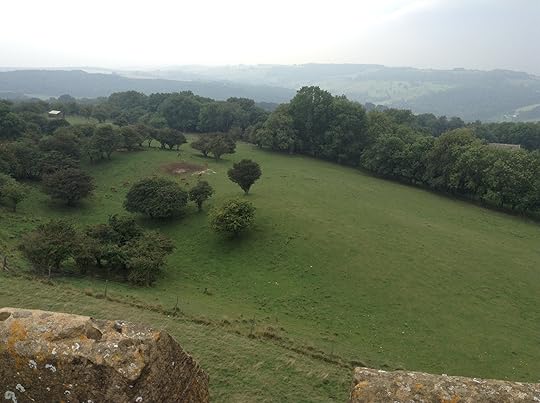
view from the top of Broadway Tower 1 Oct 2013 (photo credit Jamie Robinson)
William Morris, along with the Pre-Raphaelite brotherhood, and the members of the Arts and Crafts Movement, was one who inherited and took forward all that was good in the Romantic Movement.
Among all things most romantic to me is a high place.
I go to high places for calmness and peace.
There are a number of high places I love to visit, from where I live in Warwickshire.

Broadway Tower, Cotswolds 1 Oct 2013 (photo credit Jamie Robinson)
And just such a place, 35 minutes drive from my home, is Broadway Tower in the heart of the Cotswolds, which I have visited many times, most recently the day before writing this post.
From the top of the tower one may see, on a fine day, thirteen counties.
No wonder idealists and romantics went there in the nineteenth century after their friend took a lease on the Tower, following the death of the Tower’s creator and original owner, the Earl of Coventry. For the Tower, a picturesque folly on the summit of Broadway Hill, emerged from the romantic movement. So, too, flambuoyant, theatrical and sensual, did Painswick Rococo Garden emerge from this tradition, as I wrote in a recent review on Trip Adviser.
William Morris was just one of the many idealists and romantics who came here. His rich, complex and exquisite designs now adorn soft furnishings, and a selection of them may be seen on the second floor of the Tower.
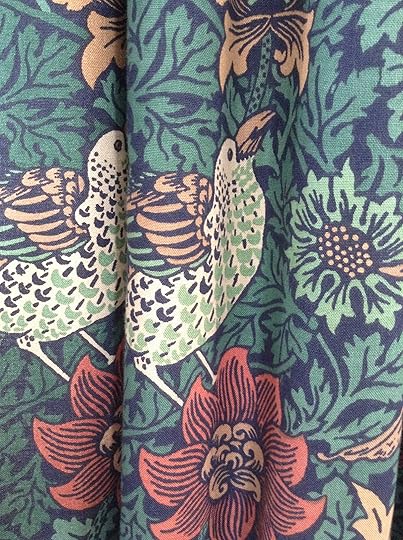
William Morris design image 1 (photo credit Jamie Robinson)
He is a beacon of romantic idealism, combining a love of medievel craftmanship and Gothic design elements.
And his association with Broadway Tower – together with that of his contemporaries of like mind – is appropriate.

William Morris design image 2 (photo credit Jamie Robinson)
It’s certainly true that I, too, feel an affinity with the Romantics, the Pre-Raphaelites, the members of the Arts & Craft movement, and their dreams and visions.
For where would we be in this life if none among us aspired to, or dreamed of impossible ideals?
Impossible?
Read the full text of The Dream of William Morris here.

The Dream of William Morris (photo credit Jamie Robinson)
Filed under: British, British landscape, buildings, culture, design, dreams and dreaming, empowerment, English countryside, history, inspiration, life, love, musings, mystery romance, nature, people of inspiration, places I love, places of inspiration, popular artists, positive thinking, SC Skillman, SC Skillman Author, thoughts, travel, UK Tagged: a high place, alive, Arts & Crafts movement, Broadway Tower, calmness, Cotswolds, dream, dreams and visions, heart, heart of the Cotswolds, idealist, ideals, in this life, peace, picturesque folly, pre-Raphaelites, romantic, SC Skillman author, the romantic movement, William Morris


September 23, 2013
In Memory of Hattie, a Beloved Pet Cat – and the Gracefulness of Letting Go
This is Hattie, born 1996, who died on 21 September 2013, at home, in her basket, peacefully, in a deep sleep.
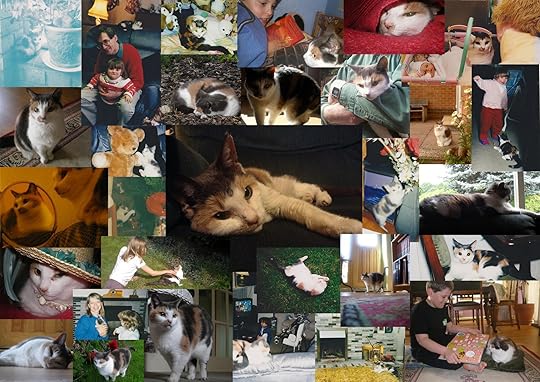
Happy memories of Hattie, beloved family pet 1996-2013 (photo credits: Abigail Robinson)
When a much-loved family pet dies we need to decide what to do next.
But we kept Hattie lying in her basket for a day and a night, nestled in her blanket, where she died.
And it was not macabre, but beautiful, and consoling.
There is something sacred about being in the presence of a peaceful death, after a life well-lived.
Lying there in the stillness and quietness of letting go, her fur still felt soft and her body pliable, and I imagined several times that she was still breathing.
She has filled 17 years of our lives with fun, laughter and affection. She has beguiled us, outwitted us, annoyed us, delighted us and demonstrated something powerful: absolute persistence wins.
I blogged about Hattie a while ago. There, I wrote about the perpetual fascination of cats.
And now Hattie has again demonstrated something powerful about this life.
The gracefulness and the quietness and the beauty of letting go.
Then, all that’s left is love.
Filed under: interpersonal relationships, life, love, musings, SC Skillman, thoughts Tagged: a life well lived, about this life, being in the presence, beloved family pet, cat, death, Hattie the cat, in this life, laughter, letting go, life, love, love cats, peaceful, peaceful death, sacred, SC Skillman author


September 17, 2013
Cutty Sark Uplifted and Renewed – Fantastic Transformation
It’s been twelve years since I last visited the Cutty Sark at Greenwich – and what a fantastic transformation.

The Cutty Sark 14 Sep 2013 (photo credit: Jamie Robinson)
Greenwich and its neighbouring Woolwich in south London are part of my family background, and so this area has been familiar to me from childhood.
This made my return to view the Cutty Sark even more inspiring.
I found the whole visit very uplifting – appropriately so, as the Cutty Sark herself has been uplifted in the most amazing way!
The exhibition area beneath the ship is excellent, with its collection of ships’ figureheads.
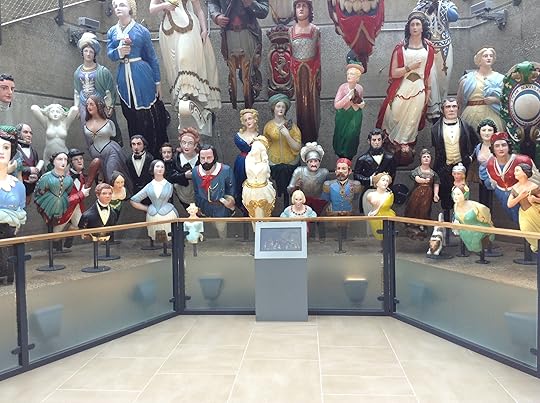
Collection of ships’ figureheads at the Cutty Sark (photo credit: Jamie Robinson)
And we were later delighted to find ourselves sitting at cafe tables with the ship apparently hovering just above us.
Everything about this attraction is first class, and it is a credit to London and to our British heritage.

The Cutty Sark uplifted (photo credit: Jamie Robinson)
The high standard is maintained in the shop, too, which is full of stylish souvenirs for sale. How could I, as a writer, resist buying myself an attractive cream and gold spiralbound notebook with the motto on the front: Where there’s a will, is a way.
This motto, carved into the ship’s elaborate decoration, is a play on the surname of Jock Willis who commissioned the Cutty Sark (launched in 1869).
For the twenty-first century transformation of the Cutty Sark can certainly be seen as a perfect illustration of this motto in action.
Filed under: British, design, empowerment, history, inspiration, life, London, love, places I love, places of inspiration, positive thinking, SC Skillman, SC Skillman Author, thoughts, travel, UK, Writing Tagged: British heritage, Cutty Sark, Greenwich, inspiring, London, renew, SC Skillman author, transformation, uplift, where there's a will, writer


September 2, 2013
And You Will Be Like a Watered Garden…

Enjoying a shady ‘small enclosed space’ in a private Kenilworth garden open for the National Gardens Scheme 1 Sep 2013 (photo credit: Abigail Robinson)
A well-watered garden is a powerful image of creativity, abundance, fruitfulness.
When asked to describe or picture heaven, I often see it as a garden.
The Prophet Isaiah, wrote these words: And the LORD will continually guide you, And satisfy your desire in scorched places, And give strength to your bones; And you will be like a watered garden, And like a spring of water whose waters do not fail.
Isaiah’s choice of a garden for his image here is perfect, as are many of the images he chose for his prophecies: an image which is profound and powerful.
A few months ago during a visit to Hidcote Manor Garden, one of the National Trust’s greatest gardens, we heard the Head Gardener say that because we’ve had a late spring this year, 2013, the plants, like people, benefit from “a good long kip” and so later on, when they flower, they will be more plentiful, more colourful and more abundant.
And so it has proved in three outstanding gardens I’ve recently visited: Upton House, near Banbury; the garden at the Shakespeare Birthplace Trust in Stratford-upon-Avon; and a private garden in Chase Lane, Kenilworth, Warwickshire, part of the Open Gardens event run by the National Gardens Scheme.
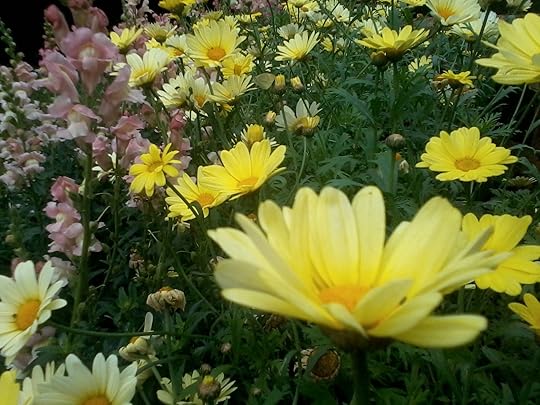
flowers in Upton House Garden 23 Aug 2013 (photo credit Abigail Robinson)
As I spend time wandering around these gardens I reflect upon what engages me most in gardens I love:
* a series of small enclosed spaces which are like outdoor rooms – little ‘dens’ where you may sit and contemplate or dream or write or do anything else creative, which are shady, secret, beautiful, tranquil, hidden;

Spending time in the garden – contemplating, dreaming, in a little ‘den’ (photo credit: Abigail Robinson)
* a number of vistas and points from which you may glimpse things either near or distant which may intrigue or surprise;
* in a grand garden with a stunning planting scheme, I’m most enchanted by combinations of depth & colour & shape which evoke different emotions in the beholder; low misty feathery plants in front, then the tall bold gold shapes behind, and finally the purple spiky angular plants at the back: a profusion of different contrasting and complementary shapes and textures.
This is what I saw in the gardens at Upton House when I visited on Friday 23 August 2013.
A predominance of pink and gold with occasional glimmers of white, lilac, purple, burgundy.
A gentle, warm fragrance filled the air; butterflies flocked to the lavender, bumble bees feasted in every direction I gazed.

Upton House Garden 23 Aug 2013 photo credit Abigail Robinson
The whole was in dynamic motion, appearing to me as a vibration of life, shimmering above and around the blossoms.
We are all indebted to those whose gift is to design gardens, select plants, and work hard to create paradise on earth: surely the goal of all the great garden designers. In this life, there is a place for all of us; those who work, those who act, those who are practical, and those who come to see, and to drink deeply, who dream, who draw inspiration, who see visions, and who believe.
Great gardens are places that feed the imagination, provide a source of inspiration, nurture creativity, enrich our dreams, lift our hearts to the divine.
For paradise is a garden.
Filed under: design, dreams and dreaming, garden design, inspiration, life, musings, National Trust gardens, nature, places I love, places of inspiration, religion, SC Skillman, SC Skillman Author, spirituality, thoughts, UK, wildlife Tagged: creativity, divine, dreams, gardens, I believe that, imagination, in this life, inspiration, life, love, paradise, vibration





